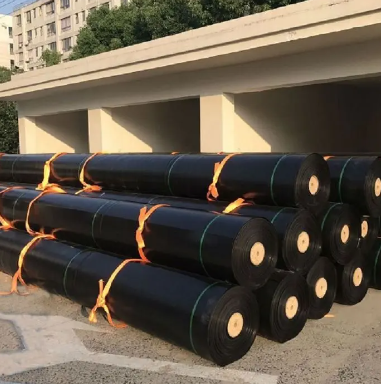- Understanding the Role of Geomembrane Liners in Waste Management
- Innovations in Geomembrane Liners for Water Management
- Geomembrane Liners: A Comprehensive Guide
- The Future of Geomembrane Liners in Civil Engineering
- Geomembrane Liners: Enhancing Landfill Stability
Manager:Alvin Wang
WhatsApp:+62 8983806051
Tel:+86 10-5797-1075
Email:steelwang@okorder.com
Address:3rd Floor, No.2 Building, No.1 Sanlihe Road
What is the difference between geomembrane and HDPE?
The terms "geomembrane" and "HDPE" are often used interchangeably in environmental engineering or civil engineering applications, which leads to similar questions about their similarities and differences. However, geomembranes are made from High Density Polyethylene (HDPE) polymer among other materials that form the basis of any containment system or lining mechanism. This piece seeks to outline the dissimilarity between a geomembrane and HDPE by defining them, investigating their uses, and expounding on their characteristics.

Understanding a geomembrane
Geomembrane refers to an artificial liner or membrane designed for the purpose of preventing fluid migration and protecting underlying structures from contamination. These include rubber, composites, polymers or many other materials which all have unique properties and advantages. They are mainly used in construction, civil engineering projects as well as environmental situations such as water treatment plants where sludge lagoons need to be created in order for the waste water treatment process to make sense.
Understanding HDPE
On the contrary, HDPE is a particular polymer utilized in making liners. High-Density Polyethylene (HDPE) is an example of a thermoplastic polymer product derived from ethylene gas as it undergoes the process of polymerization. This makes it one of the best alternatives for this kind of usage due to its excellent strength against chemicals such as acids and bases; flexibility; resistance to extreme temperatures; high tensile strength; stiffness; durability among others. It is applied widely in various containment systems thus acting as an effective barrier against seepage while ensuring long-term structural integrity.
Composition and Structure
Geomembranes refer to synthetic liners used in containment applications whereas HDPE refers specifically to those made out of High Density Polyethylene resin:
- Geomembrane: The term “geomembrane,” however, refers generally to all kinds of synthetic liners employed in containment. This implies that geomembranes may be constructed from different materials including HDPE, XR-5, LLDPE, EPDM as well as PVC among others. Geomembranes have different compositions; and thickness, flexibility and performance attributes determined by the specific material used.
- HDPE: this is a type of geomembrane that is derived from High-Density Polyethylene resin. Such are made of interconnected networks of high density polyethylene molecules which form a compact structure. These unique features are what make hdpe Geomembranes to be characteristically known for their durability, flexibility, chemical resistance and impermeability.
Applications
Both geomembrane and HDPE can be used in a variety of civil engineering and environmental projects including:
- Geomembrane: In addition to landfills, ponds, reservoirs, wastewater treatment facilities as well as mining operations among others where fluids should not escape. They also help to protect soil and water resources while ensuring that companies stay compliant with relevant environmental laws.
- HDPE: However, it is noted that such are most commonly used in those cases where exceptional durability; flexibility; chemical resistance; tensile strength etc. Therefore they are quite popularly used to line hazardous waste sites such as industrial ponds and landfill liners since they can guarantee long-term operation throughout the service life.
Physical and Mechanical Properties
Where physical and mechanical properties tend to be somewhat similar for both types of geomembranes there are still points at which these products diverge:
- Flexibility: The extent to which these materials bend depends on the particular material involved. On the other hand, when it comes to High Density Polyethylene (HDPE) geomembranes their flexibility is high enough allowing them to conform themselves on irregular or uneven surfaces as well accommodate any ground movement beneath without cracking or tearing due to dynamic loads overburdening them.
- Chemical Resistance: Nevertheless both types of lining systems are chemically resistant, the strength of HDPE geomembranes lies in its ability to withstand reactions with acids, strong bases and solvents like hydrocarbon compounds which are commonly used for storing corrosive chemicals or disposing industrial wastes.
- Impermeability: The function of geomembranes and HDPE geomembranes is to act as a barrier that cannot be penetrated by any fluid. The reason for this is because HDPE geomembranes are not permeable to liquid or gas hence making them the most suitable material for containment systems in terms of effective containment and environmental protection.

Conclusion
In conclusion, although the term geomembrane is used generically to describe synthetic liners which are used in containment applications, HDPE specifically refers to geomembrane made from High-Density Polyethylene resin. Critical containments often require long-lasting performance and reliability, HDPE geomembrane offers excellent durability, flexibility, chemical resistance and impermeability. Therefore, experts in relevant fields such as engineering can make informed selections on materials they use for their containment as well as lining systems by simply knowing the difference between Geomembrane and HDPE so that they can effectively plan for its projects’ longevity.
-
2024-12-05Geomembrane Liners: A Comprehensive Guide






